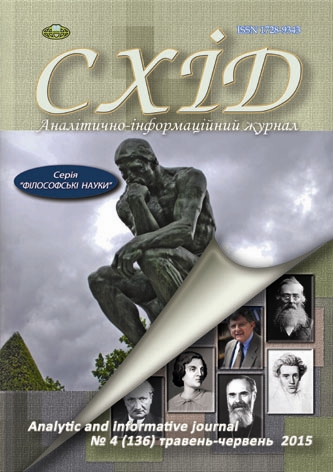Project of fundamental ontology: transformation or overcoming phenomenology?
DOI:
https://doi.org/10.21847/1728-9343.2015.4(136).48330Keywords:
Heidegger, ontology, phenomenological method, hermeneutics, phenomenon, DaseinAbstract
In his paper the author considers the issue of phenomenological destruction in the works by M. Heidegger, which was finalized in Heidegger’s fundamental book «Being and Time».
The dynamics of Heidegger’s methodological search is presented, beginning from his lecture courses in the 1920s. It is shown that practical (primary) experience is gained owing to description of experience of Christian life in the Letters of Paul the Apostle. Heidegger modifies his own methodology then in the Phenomenological interpretations of Aristotle. The main phenomenon in the above work changes its nature: it exists in the concealed way rather than is directly given and phenomenological destruction is therefore modified to some extent. In The Hermeneutics of Facticity Heidegger’s methodological position is further developed. For now facticity means the existential nature of “our own existence here”, whereas the term Dasein itself completely replaces a rather unclear concept of life.
In «Being and Time» Heidegger eventually re-interprets all the main concepts: phenomenology, ontology and hermeneutics to the extent that at different stages of his work he totally discards them. And a subsequent explication of the concept of phenomenon radically transforms the project of phenomenological research itself: the first phenomenon mainly conceals itself rather than reveals. According to the author of the paper, such research method can be named in different ways (destruction, hermeneutics etc.), but naming it a phenomenological method means assigning to the terms of phenomenology and phenomenological the meanings alien to them.Downloads
References
Baumeister A. (2013), Filosofska dumka, №4, p. 96-112 (ukr).
Baumeister A. (2012), Sententiae, Vol. XXVII (№2), Vinnytsia - Kyiv, p. 46-59 (ukr).
Baumeister A. (2013), Sententiae, Vol. ХХVIIІ (№1), Vinnytsia - Kyiv, p. 63-75 (ukr).
Heidegger M. (2007), Sein und Zeit, Akademie Verlag GmbH, 320 s. doi: 10.1524/9783050050171 (germ).
Grondin J. (2015), Die Wiedererweckung der Seinsfrage auf dem Weg einer phänomenologisch-hermeneutischen Destruktion in: Martin Heidegger. Sein und Zeit (Hrsg. Thomas Rentsch), de Gruyter, 1-26. doi: 10.1515/9783110379396.1 (germ).
Dreyfus H.L. (2012), ‘Being-with-Others’, in Wrathall M.A. (ed.) The Cambridge Companion to Heidegger’s Being and Time. Cambridge, Cambridge University Press, doi: https://doi.org/10.1017/CCO9781139047289.007
Bohachov Andrii (2011), Experience and Meaning, Kyiv, 336 p. (ukr).
Figal G. (1982), Selbstverstehen in instabiler Freiheit. Die hermeneutische Position Martin Heidegger, in: Hendrik Birus (Hrsg.). Hermeneutische Positionen. Schleiermacher. Dilthey. Heidegger. Gadamer, Vandenhoeck & Ruprecht, Göttingen, s. 89-119 (germ).
Grondin J. (2001), Von Heidegger zu Gadamer. Unterwegs zur Hermeneutik, Wissenschaftliche Buchgesellschaft, Stuttgart, 167 s. (germ).
Merker B. (2001), Die Sorge als Sein des Daseins, in: Martin Heidegger. Sein und Zeit (Hrsg. Thomas Rentsch), Akademie Verlag, Berlin, s. 117-132. doi: 10.1524/9783050050171.117 (germ).
Downloads
Published
How to Cite
Issue
Section
License
Copyright (c) 2015 Andrii Baumeister

This work is licensed under a Creative Commons Attribution-NonCommercial-NoDerivatives 4.0 International License.
1. Authors bear responsibility for the accuracy of facts, quotations, numbers and names used.
2. Manuscripts are not sent back.
3. The publisher does not always agree with the authors' opinion.
4. The authors reserve the right to authorship of the work and pass the first publication right of this work to the journal under the terms of a Creative Commons Attribution-NonCommercial-NoDerivatives 4.0 International License. This license allows others to distribute (copy) the published work for non-commercial purposes, provided there is mandatory attribution to its authors and a link to the first publication in our journal.
5. The authors have the right to conclude separate supplement agreements that relate to non-exclusive work distribution in the form in which it has been published by the journal (for example, to upload the work to the online storage of the journal or publish it as part of a monograph), provided that the reference to the first publication of the work in this journal is included.

